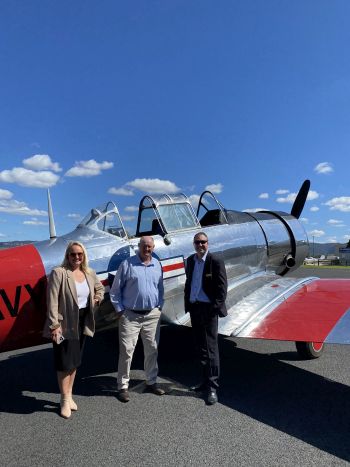City of Newcastle will take on greater leadership in NSW through new accords with Upper Hunter, Muswellbrook and City of Coffs Harbour councils.
Newcastle has entered memoranda of understanding (MoU) with two of our Hunter neighbours, as well as fellow regional coastal council Coffs Harbour.
 Newcastle Lord Mayor Nuatali Nelmes, Upper Hunter Shire Mayor Maurice Collison and Muswellbrook Shire Mayor Steve Reynolds at a recent meeting of the Hunter Joint Organisation.
Newcastle Lord Mayor Nuatali Nelmes, Upper Hunter Shire Mayor Maurice Collison and Muswellbrook Shire Mayor Steve Reynolds at a recent meeting of the Hunter Joint Organisation.
Newcastle Lord Mayor Nuatali Nelmes said the four councils will gain valuable expertise and a stronger collective voice from each MoU.
“We’re in a unique position to both be a leader in the local government sector and to learn from the successes of other councils,” Cr Nelmes said.
“As a financially sound and well-resourced council, we have plenty of success stories that are worth sharing and I look forward to exploring new opportunities through closer ties with our neighbours.
“Newcastle, Coffs Harbour, Muswellbrook and the Upper Hunter are each vital parts of our state, and we’re stronger, smarter and better off when we collaborate.”
City of Newcastle Acting CEO David Clarke said the accords would pool the knowledge of each council in many areas of expertise.
“We’re exploring opportunities to share insights and capabilities, as well as the potential for staff exchange program with our MoU partners, which is a golden way to share the rich expertise of each council and just one of the many benefits of these agreements,” Mr Clarke said.
“We’ve already applied for grants in partnership with some of the councils to fund projects together and had had success working with the NSW Government. City of Newcastle’s CEO Jeremy Bath has worked hard on this and deserves a lot of credit.”
As part of the MoU, City of Newcastle’s planning team has already met with their Muswellbrook and Upper Hunter counterparts to outline Newcastle’s award-winning Accelerated Development Assessment program.
City of Newcastle has applied for grant funding to roll out Accelerated Development Assessment – its streamlined determination tool for low-impact developments – to its three new MoU partners over the next 12 months.
In the past year, Newcastle and Coffs Harbour have worked together on a range of submissions to the NSW and federal governments on issues that affect both large coastal councils.
Coffs Harbour Mayor Paul Amos said the coastal council areas’ similarities made them logical partners.
“This is a tremendous opportunity for Coffs Harbour to work closely with Newcastle on all manner of things, and the MoU will be of particular advantage in areas where challenges are common to both councils,” Cr Amos said.
“It makes every sense for Coffs and Newcastle to align as two major regional, coastal cities – each with ambition for continual improvement.
“While the MoU is non-binding on either council for any actions, it paves the way for a mutually beneficial partnership.”
Muswellbrook Shire Mayor Steve Reynolds said his council saw its Newcastle MoU as mutually beneficial.
“We look forward to working with the City of Newcastle and exploring opportunities for joint advocacy and funding prospects to benefit the region and enhance our capability,” Cr Reynolds said.
“Improved efficiencies and learnings will support better outcomes across the board.”
Upper Hunter Shire Mayor Maurice Collison said his council’s new accord would bring a suite of benefits.
“By collaborating across boundaries, we can share valuable knowledge and resources, leading to enhanced service delivery and sustainable regional growth,” Cr Collison said.
“This MoU represents our commitment to working together for the economic and social prosperity of our communities. Our combined efforts will ensure that we are better equipped to address the complex issues facing local government.”
